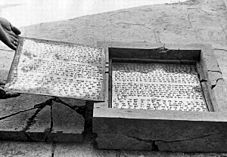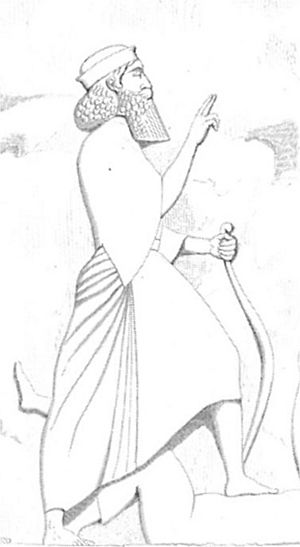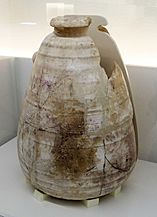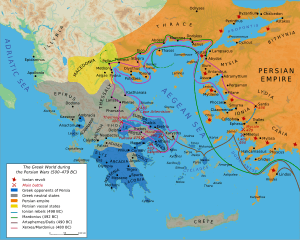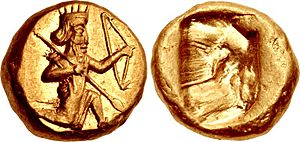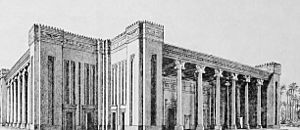Darius the Great facts for kids
Quick facts for kids Darius the Great𐎭𐎠𐎼𐎹𐎺𐎢𐏁 |
|||||
|---|---|---|---|---|---|
|
|||||

The relief stone of Darius the Great in the Behistun Inscription
|
|||||
| King of Kings of the Achaemenid Empire | |||||
| Reign | 29 September 522 BCE – October 486 BCE | ||||
| Coronation | Pasargadae | ||||
| Predecessor | Bardiya | ||||
| Successor | Xerxes I | ||||
| Pharaoh of Egypt | |||||
| Reign | September 522 BCE – October 486 BCE | ||||
| Predecessor | Bardiya | ||||
| Successor | Xerxes I |
||||
| Born | c. 550 BCE | ||||
| Died | October 486 BCE (aged approximately 64) |
||||
| Burial | Naqsh-e Rostam | ||||
| Spouse |
|
||||
| Issue |
|
||||
|
|||||
| Dynasty | Achaemenid | ||||
| Father | Hystaspes | ||||
| Mother | Rhodogune or Irdabama | ||||
| Religion | Indo-Iranian religion (possibly Zoroastrianism) |
||||
Darius I, also known as Darius the Great, was a powerful Persian ruler. He became the third King of Kings of the Achaemenid Empire. He ruled from 522 BCE until his death in 486 BCE. During his reign, the empire reached its largest size. It included lands from Western Asia, parts of the Balkans, the Caucasus, and much of the Black Sea coast. It also stretched to Central Asia, the Indus Valley in the east, and parts of North Africa like Egypt.
Darius took the throne by overthrowing the previous ruler, Bardiya. He claimed Bardiya was an impostor. After becoming king, Darius faced many rebellions across his vast kingdom. He successfully put down all of them. A major goal for Darius was to conquer Greece. He wanted to punish Athens and Eretria for helping in the Ionian Revolt. Even though his campaign failed at the Battle of Marathon, he did regain control of Thrace. He also expanded the empire by conquering Macedon, the Cyclades, and the island of Naxos. He also sacked the Greek city of Eretria.
Darius was a brilliant organizer. He divided the empire into provinces called satrapies, each with its own governor. He created a new, standard money system using Achaemenid coinage. He also made Aramaic an official language alongside Persian. To improve the empire, he built roads and introduced standard weights and measures. These changes made the Achaemenid Empire more organized and united. Darius also started many building projects. He focused on cities like Susa, Pasargadae, Persepolis, Babylon, and Egypt. He had the Behistun Inscription carved into a cliff. This inscription recorded his victories and is an important source for the Old Persian language.
Darius is also mentioned in the Hebrew Bible. You can find him in the books of Haggai, Zechariah, and Ezra–Nehemiah.
Contents
What Does the Name Darius Mean?

The name Darius comes from the Greek word Dareios. This word itself comes from the Old Persian word Dārayauš. This longer form was Dārayavaʰuš. The name means "he who holds firm the good". The first part, dāraya, means "holder". The second part, vau, means "goodness".
How Do We Know About Darius?
We learn about Darius from several important sources. One key source is the Behistun Inscription. This huge carving on Mount Behistun tells Darius's story. It is written in three languages: Elamite, Old Persian, and Babylonian. The inscription starts with Darius's family history. It also describes how he became king and his many victories. Darius often says that he became king with the help of his god, Ahura Mazda.
Other texts and monuments from Persepolis also tell us about Darius. There is also a clay tablet with his name found in Gherla, Romania. A letter from Darius to a man named Gadates also exists.
Herodotus, a famous Greek historian, also wrote a lot about Darius. His book, The Histories, describes many Persian kings. It also covers the Greco-Persian Wars. Herodotus's writings explain how Darius took power. They also cover events until the end of Darius's rule.
Darius's Early Life and Becoming King
Darius was the oldest of five sons of Hystaspes. His mother's name is not fully clear. Some historians say she was Rhodogune. Others believe she was Irdabama, a wealthy landowner. Darius's father, Hystaspes, was a high-ranking officer in Cyrus the Great's army. He was also a noble in Cyrus's court.
Before Darius became king, he served as a spearman for King Cambyses II. This was during Cambyses's campaign in Egypt. This role was very important.
There are different stories about how Darius became king. Darius's own account, from the Behistun Inscription, says that Cambyses II killed his brother Bardiya. But the Persian people did not know about this murder. Then, a man named Gaumata pretended to be Bardiya. He lied to the people, saying he was the true king. The people were unhappy with Cambyses's rule. So, they chose Gaumata as their leader.
No one from the royal family dared to challenge Gaumata. But Darius, who had served Cambyses, decided to act. In September 522 BCE, Darius and six other nobles killed Gaumata. This happened in a fortress called Sikayauvati.
The Greek historian Herodotus tells a different, more dramatic story. He says that after Gaumata was killed, Darius and the six nobles discussed what kind of government Persia should have. Darius argued for a monarchy, where one king rules. He convinced the others that a monarchy would be the strongest.
To choose the new king, they agreed on a test. They would gather outside the palace at sunrise on their horses. The man whose horse neighed first would become king. Darius had a clever slave named Oebares. Oebares made Darius's horse neigh first. Right after, there was lightning and thunder. This made the others believe Darius was chosen by the gods. They knelt before him, and Darius became king.
Historians today believe that Darius's story about Gaumata was a way to make his rule seem more rightful. In reality, Darius likely overthrew and killed Bardiya, who was the true heir of Cyrus. To make his rule stronger, Darius connected his family to Cyrus's family. He said that Achaemenes was the founder of both their families.
Darius's First Years as King
After becoming king in Pasargadae, Darius moved to Ecbatana. He soon found that many people still supported Bardiya. Rebellions broke out in Elam and Babylonia. Darius quickly crushed the Elamite revolt. Its leader, Aschina, was captured and executed. The Babylonian revolt ended after three months.
While in Babylonia, Darius heard about more revolts. These spread to Bactria, Persis (the Persian homeland), Media, Parthia, Assyria, and Egypt. By 522 BCE, most of the Achaemenid Empire was in chaos. Even though Darius did not have everyone's support, he had a loyal army. This army was led by his close friends and the six nobles who helped him become king. With their help, Darius put down all the rebellions within a year. Darius said he defeated nine "lying kings" during these revolts. He wrote all about these events in the Behistun Inscription.
Darius's Military Campaigns
Conquering Egypt and Expanding the Empire
After making sure he was firmly in charge of the empire, Darius led a campaign to Egypt. He defeated the Egyptian armies and secured the lands that King Cambyses had conquered. He made a large part of Egypt a part of the Achaemenid Empire.
Through other military campaigns, Darius I expanded the empire even further. It stretched from parts of the Balkans in the west to the Indus Valley in the east. This was the largest the empire ever became.
Invading the Indus Valley

In 516 BCE, Darius began a campaign into Central Asia. He marched through Afghanistan to Taxila in modern-day Pakistan. Darius spent the winter of 516–515 BCE in Gandhara. He was preparing to conquer the Indus Valley. In 515 BCE, Darius conquered the lands around the Indus River. He controlled the Indus Valley from Gandhara to modern Karachi. He also sent the Greek explorer Scylax of Caryanda to explore the Indian Ocean. After his conquests, Darius returned to Persia.
Putting Down the Babylonian Revolt
After the previous ruler Bardiya was killed, many revolts happened across the Achaemenid Empire. The most important one was the Babylonian revolt, led by Nebuchadnezzar III. This revolt started when many soldiers were moved from Babylon to help Darius with other rebellions. Darius felt the Babylonians had betrayed him. He gathered a large army and marched to Babylon.
When Darius arrived, the city gates were closed. The Babylonians had strong defenses. They even mocked Darius, saying he would only capture their city "when mules shall have foals." For a year and a half, Darius could not take the city. He tried many tricks, even copying what Cyrus the Great had done to capture Babylon before.
The situation changed when, surprisingly, a mule owned by a high-ranking soldier named Zopyrus gave birth. This was seen as a sign. Zopyrus then pretended to be a deserter and entered the Babylonian camp. He gained their trust. This plan worked, and Darius's army eventually surrounded and defeated the rebels.
During this time, Scythian nomads also invaded Persia. Darius first defeated the rebels in other areas. Then he attacked the Scythian invaders.
The European Scythian Campaign
The Scythians were nomadic tribes from northern Iran. They had invaded Media and even killed Cyrus the Great in battle. They revolted against Darius and threatened trade routes. They lived between the Danube River, the Don River, and the Black Sea.
Darius crossed the Black Sea at the Bosphorus Straits using a bridge made of boats. He conquered large parts of Eastern Europe. He even crossed the Danube to fight the Scythians. In 513 BC, Darius invaded European Scythia. The Scythians avoided direct battles. They used tricks, retreating eastward and destroying the land. They blocked wells, stopped supply convoys, and burned pastures. They also had small fights with Darius's army.
Darius wanted a direct battle. He sent a letter to the Scythian ruler, Idanthyrsus, asking him to fight or surrender. The ruler replied that they would not fight until Darius found and tried to destroy their fathers' graves. Until then, they would continue their strategy. They had no cities or farms to lose.
Despite the Scythians' tactics, Darius's campaign was somewhat successful. The Scythians lost their best lands and their allies were harmed. Darius moved eastward into the farmed lands of the Scythians. His fleet kept him supplied. He also lived off the land. He captured and burned a large city of the Budini, who were Scythian allies.
Darius eventually stopped at the Oarus River. He built "eight great forts" there, about 8 miles apart. These were likely for defense. After chasing the Scythians for a month, Darius's army was tired and sick. Darius decided to stop the chase and head towards Thrace. He had conquered enough Scythian land to make them respect Persian power.
The Persian Invasion of Greece
Darius's European expedition was a major event. It started with the invasion of Thrace. Darius also conquered many cities in the northern Aegean Sea and Paeonia. Macedonia willingly joined the empire, becoming a vassal kingdom. Darius then left his general Megabyzus to conquer Thrace. He returned to Sardis for the winter.
Many Greeks living in Asia Minor and on some Greek islands had already accepted Persian rule by 510 BCE. Some Greeks were even friendly to Persia, especially in Athens. To improve relations, Darius welcomed Greeks who wanted to serve him. These Greeks worked as soldiers, artists, and sailors for Darius. However, Greeks became more worried about the growing power of Darius's kingdom. Also, the constant interference by Greeks in Ionia and Lydia led to conflict between Persia and some leading Greek city-states.
When Aristagoras started the Ionian Revolt, Eretria and Athens helped him. They sent ships and troops to Ionia and burned Sardis. Persian forces put down the revolt. They reoccupied Ionian and Greek islands. They also regained control of Thrace and conquered Macedonia in 492 BCE. Macedonia had been a vassal kingdom, but Darius made it a fully controlled part of the Persian kingdom. These military actions were a direct response to the Ionian revolt. They marked the beginning of the First Persian invasion of mainland Greece. At the same time, groups in Athens who were against Persia gained more power. Pro-Persian nobles were forced to leave Athens and Sparta.
Darius sent troops led by his son-in-law across the Hellespont. But a strong storm and attacks from the Thracians forced the troops to return to Persia. Darius wanted revenge on Athens and Eretria. He gathered another army of 20,000 men. This army was led by his Admiral, Datis, and his nephew Artaphernes. They succeeded in capturing Eretria and advanced to Marathon. In 490 BCE, at the Battle of Marathon, the Persian army was defeated. A strong Athenian army of 9,000 men, supported by 600 from Plataea, and 10,000 lightly armed soldiers, led by Miltiades, won the battle.
The defeat at Marathon ended the first Persian invasion of Greece. Darius began planning a second, larger invasion. This time, he planned to lead the armies himself. However, before he could finish preparing, Darius died. He left the task to his son, Xerxes I.
Darius's Family and Successors
Darius was the son of Hystaspes and the grandson of Arsames. Darius had many wives and children. He married Atossa, the daughter of Cyrus. With her, he had four sons: Xerxes, Achaemenes, Masistes, and Hystaspes. He also married Artystone, another daughter of Cyrus. They had two sons, Arsames and Gobryas. Darius married Parmys, the daughter of Bardiya, and they had a son, Ariomardus. He also married Phratagune, with whom he had two sons, Abrokomas and Hyperantes. He also married Phaidyme, a noblewoman.
Before these royal marriages, Darius had married a daughter of his friend Gobryas. With her, he had three sons: Artobazanes, Ariabignes, and Arsamenes. Although Artobazanes was Darius's first-born son, Xerxes became the next king. This was because Atossa had great influence in the kingdom, as Darius loved her the most.
Darius's Death and Who Ruled Next

After learning about the Persian defeat at the Battle of Marathon, Darius started planning another expedition against the Greek city-states. This time, he wanted to lead the armies himself. Darius spent three years preparing for war. But then, a revolt broke out in Egypt. This revolt made his health worse and stopped him from leading another army. Soon after, Darius died.
In October 486 BCE, his body was prepared and buried in a tomb carved into a rock at Naqsh-e Rostam. He had been preparing this tomb for himself. An inscription on his tomb calls him "Great King, King of Kings, King of countries containing all kinds of men, King in this great earth far and wide, son of Hystaspes, an Achaemenian, a Persian, son of a Persian, an Aryan [Iranian], having Aryan lineage."
Xerxes I, the oldest son of Darius and Atossa, became the next king. Before he became king, he had to compete with his older half-brother Artobarzanes. Artobarzanes was Darius's oldest son from his first wife. With Xerxes becoming king, the empire was again ruled by a member of Cyrus's family.
How Darius Organized His Empire
Organizing the Government
Early in his reign, Darius wanted to organize the empire better. He also wanted to improve the tax system he had inherited. To do this, Darius created twenty provinces. These were called satrapies. Each satrapy had a satrap (governor) in charge. Darius also set fixed amounts of tribute that each satrapy had to pay.
Most of the satraps were Persian nobles. They were often members of the royal family or from important noble families. Darius chose these satraps himself to manage the provinces. Each province was also divided into smaller areas. These had their own governors, chosen by the royal court or the satrap.
To make sure no one person became too powerful, each satrap had a secretary. This secretary watched over the state's affairs and reported to Darius. There was also a treasurer who managed the money. A garrison commander was in charge of the troops. Royal inspectors, known as Darius's "eyes and ears," also checked on each satrap.
The empire's administration was managed by offices in Persepolis, Susa, and Babylon. Other cities like Bactria and Memphis also had branches. Darius kept Aramaic as the common language. It quickly spread across the empire. However, Darius also had scholars create a special language system just for the Persian homeland and Persians. This was called Aryan script and was used for official inscriptions.
Improving the Economy
Darius introduced a new, standard currency called the daric before 500 BCE. This currency helped control trade and business throughout his empire. The daric was even accepted outside the empire. There were two types of darics: gold and silver. Only the king could make gold darics. Important generals and satraps made silver darics. The daric greatly boosted international trade. Goods like textiles, carpets, tools, and metal objects traveled across Asia, Europe, and Africa.
To further improve trade, Darius built the Royal Road. He also set up a postal system and encouraged sea trade. The daric also increased government income. It made it easier to collect new taxes on land, animals, and markets. This led to land being measured and taxed. The extra money helped maintain and improve roads and other structures. It also funded irrigation projects in dry areas. This new tax system also led to the creation of state banking and banking firms. One famous firm was Murashu Sons in Nippur. These firms offered loans and credit.
Darius also built canals and underground waterways. He also created a strong navy. He improved and expanded the network of roads and way stations across the empire. This allowed the king, satraps, and other officials to get supplies at daily stops.
Darius's Religious Beliefs
Historians are not completely sure if Darius was influenced by Zoroastrianism. However, it is clear that Darius strongly believed in Ahura Mazda. He saw Ahura Mazda as the most important god. Ahura Mazda was also worshipped by followers of the (Indo-)Iranian religion.
As seen in the Behistun Inscription, Darius believed that Ahura Mazda had chosen him to rule the Achaemenid Empire. Darius had strong beliefs about good and evil. He thought that every rebellion in his kingdom was the work of druj, which means "falsehood" or "evil." Darius believed that because he lived righteously, Ahura Mazda supported him. In many inscriptions, he presents himself as a very religious ruler. He might have even believed he had a divine right to rule the world.
In the lands his empire conquered, Darius showed the same tolerance for different faiths that Cyrus had. He supported religions that were "foreign" as long as their followers were peaceful. Sometimes, he even gave them money from his treasury. He funded the rebuilding of the Israelite temple, which Cyrus had first allowed. He also supported Greek cults and Elamite priests. He observed Egyptian religious customs related to kingship and built a temple for the Egyptian god, Amun.
Building Projects by Darius

During his reign, Darius started many building projects. These were in Susa, Egypt, and Persepolis. He connected the Red Sea to the Nile River by building a canal. This canal ran from modern Zaqāzīq to modern Suez. To open this canal, he traveled to Egypt in 497 BCE. The opening was a big celebration. Darius also built a canal to connect the Red Sea and the Mediterranean. During this visit to Egypt, he put up monuments.
When Darius returned to Persis, he found that Egyptian law had been written down. Darius also sponsored large construction projects in Susa, Babylon, Egypt, and Persepolis. In Susa, Darius built a new palace complex in the north of the city. An inscription says the palace was destroyed later but rebuilt. Today, only glazed bricks from the palace remain, mostly in the Louvre museum. In Pasargadae, Darius finished all the building projects that Cyrus the Great had left incomplete. A palace was also built during Darius's reign. It has an inscription with Cyrus the Great's name. People used to think Cyrus built it, but because of the writing style, it is now believed Darius built it.
In Egypt, Darius built many temples and restored old ones. Even though Darius believed in Ahura Mazda, he built temples for the gods of the Ancient Egyptian religion. Several temples found were for Ptah and Nekhbet. Darius also created new roads and routes in Egypt. The monuments Darius built often had inscriptions in the official languages of the Persian Empire. These included Old Persian, Elamite, Babylonian, and Egyptian hieroglyphs. To build these monuments, Darius hired many workers and artists from different countries. Some of these workers were people who had been moved from their homes specifically for these projects. These workers helped the empire's economy and improved cultural connections. When Darius died, construction projects were still ongoing. His son Xerxes finished these works and even added new buildings of his own.
Images for kids
-
Egyptian statue of Darius I, shown as Pharaoh of the Twenty-seventh Dynasty of Egypt. Made between 522–486 BC, it is 2.46 meters tall and is in the National Museum of Iran (Teheran).
-
Darius as Pharaoh of Egypt at the Temple of Hibis.
-
A relief showing Darius I giving lettuces to the Egyptian god Amun-Ra Kamutef at the Temple of Hibis.
Error: no page names specified (help).
- Dariush
- Darius the Mede
- List of biblical figures identified in extra-biblical sources
See also
 In Spanish: Darío I para niños
In Spanish: Darío I para niños


